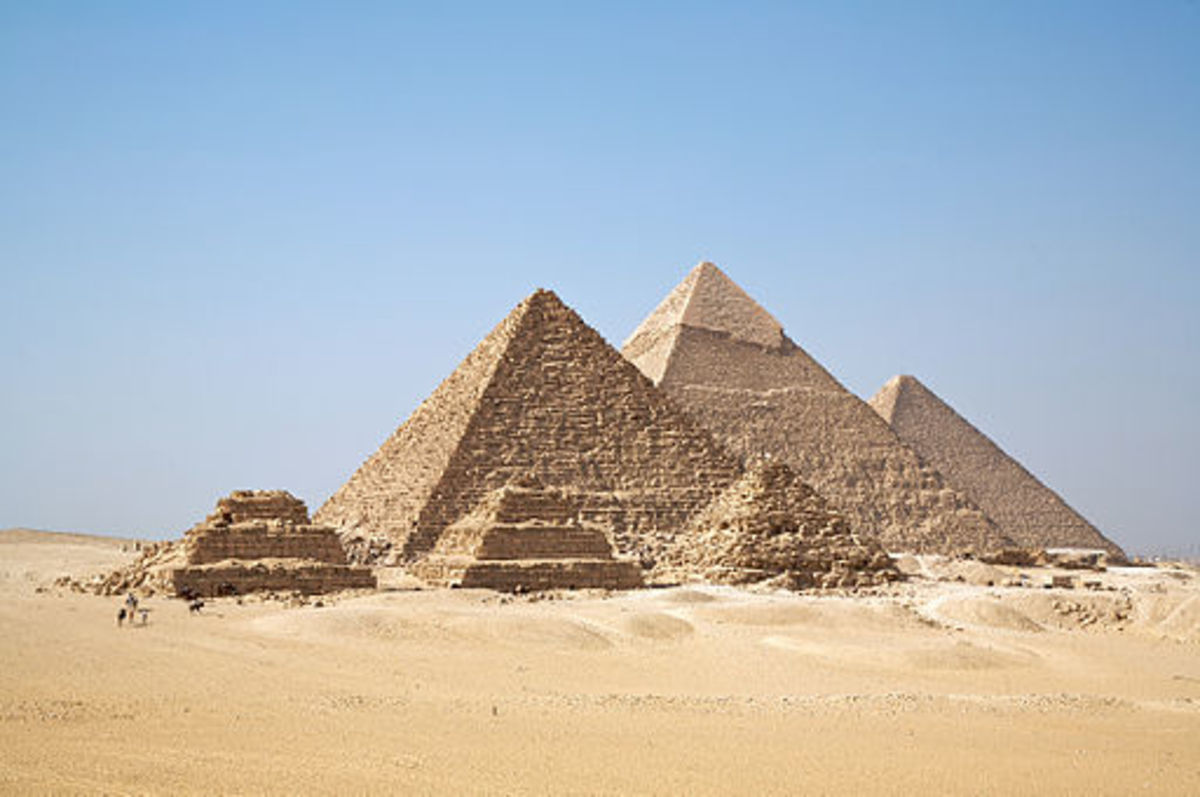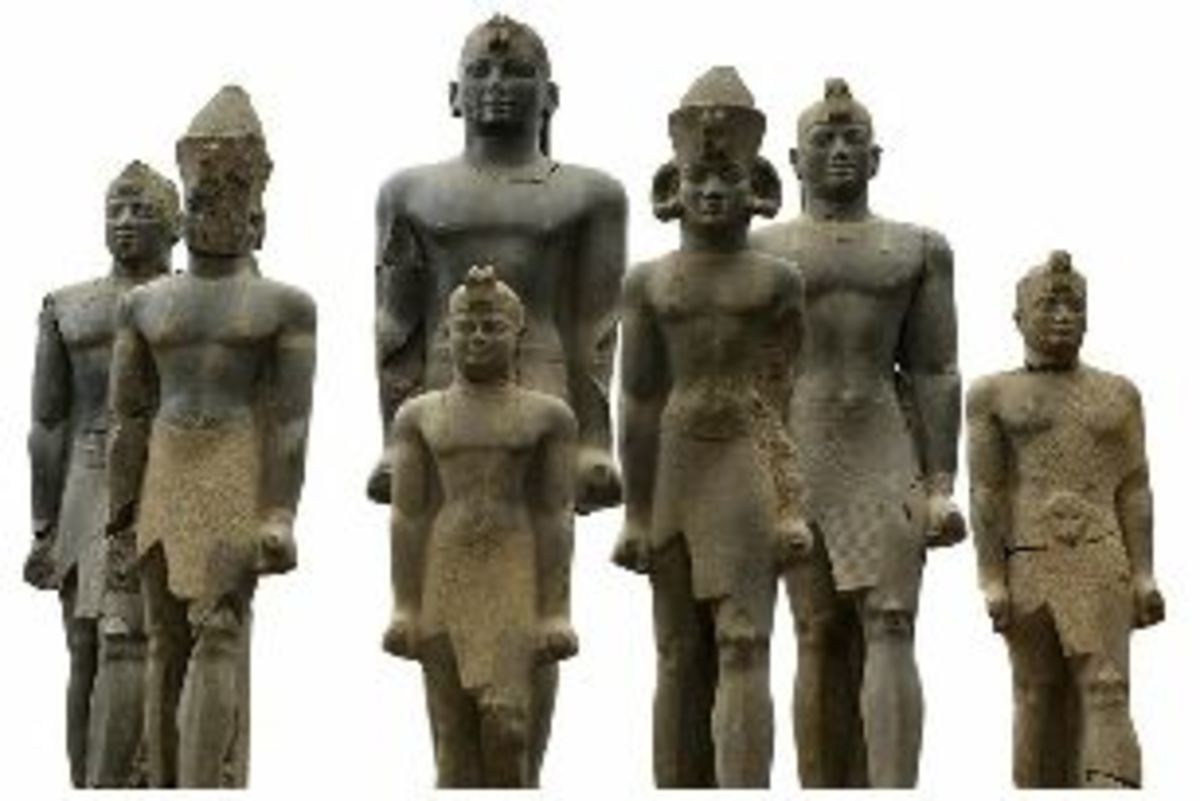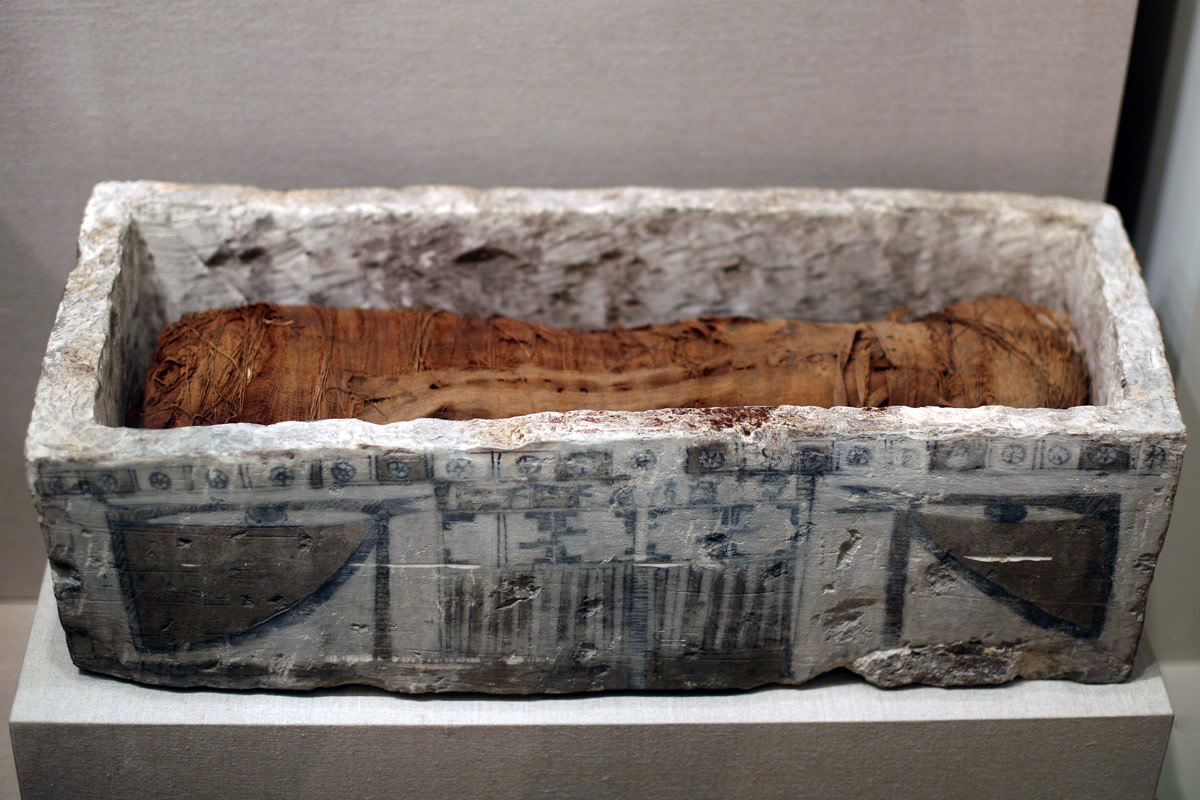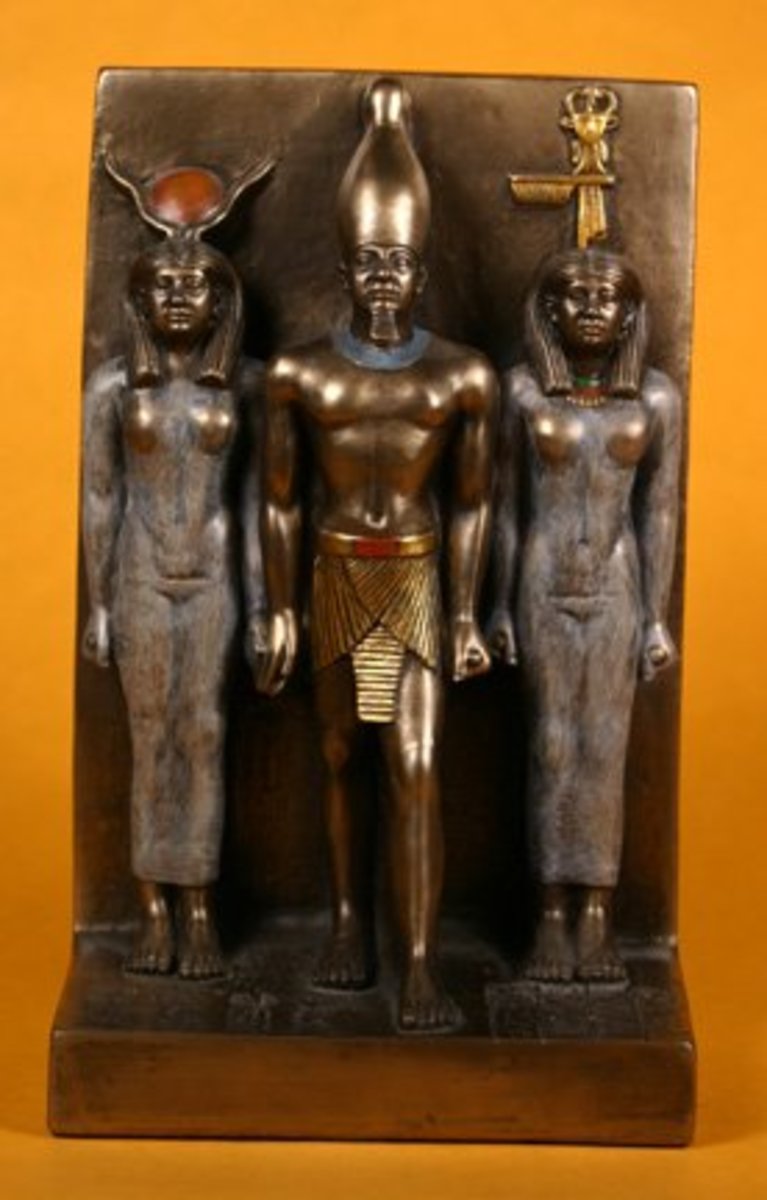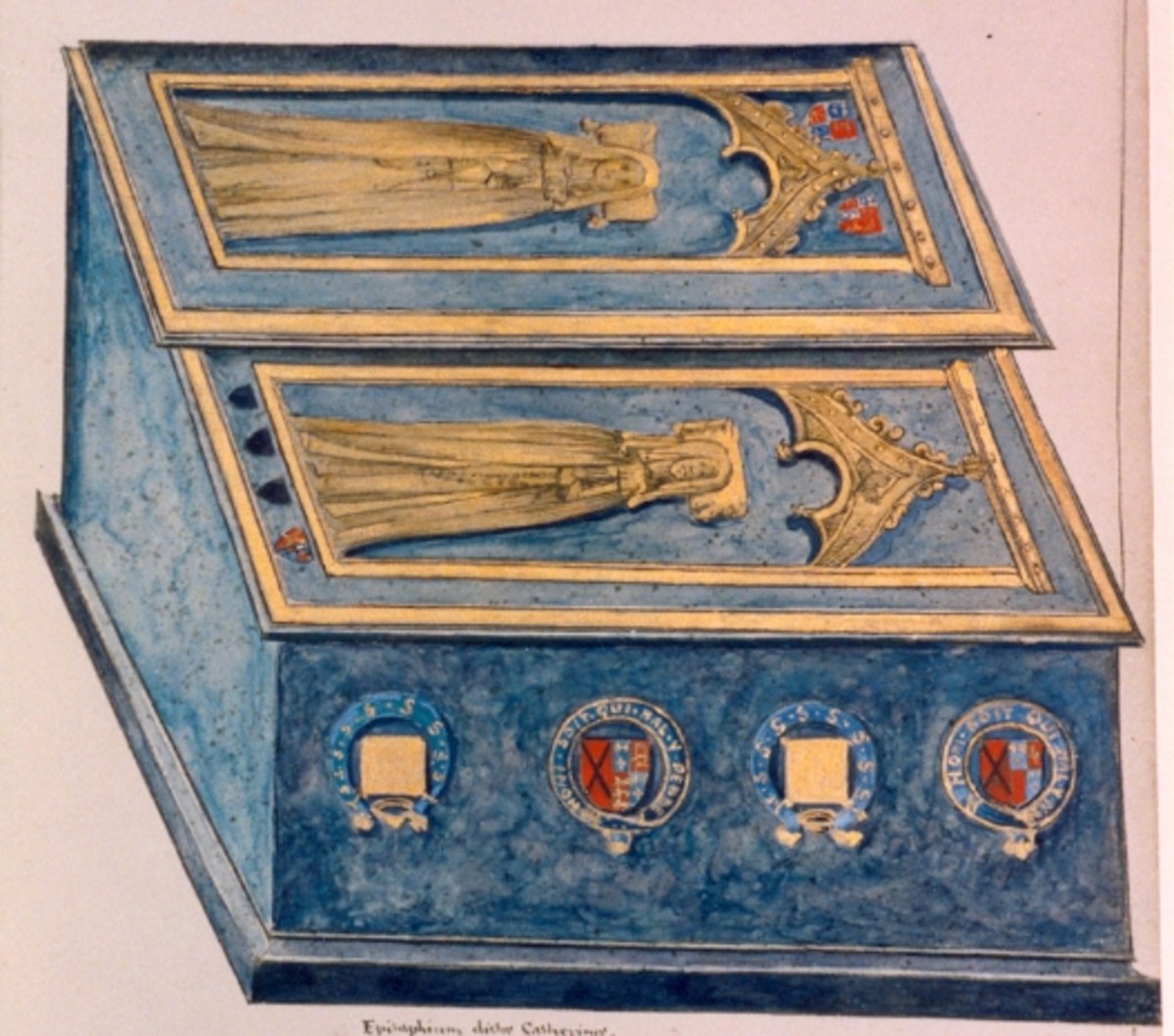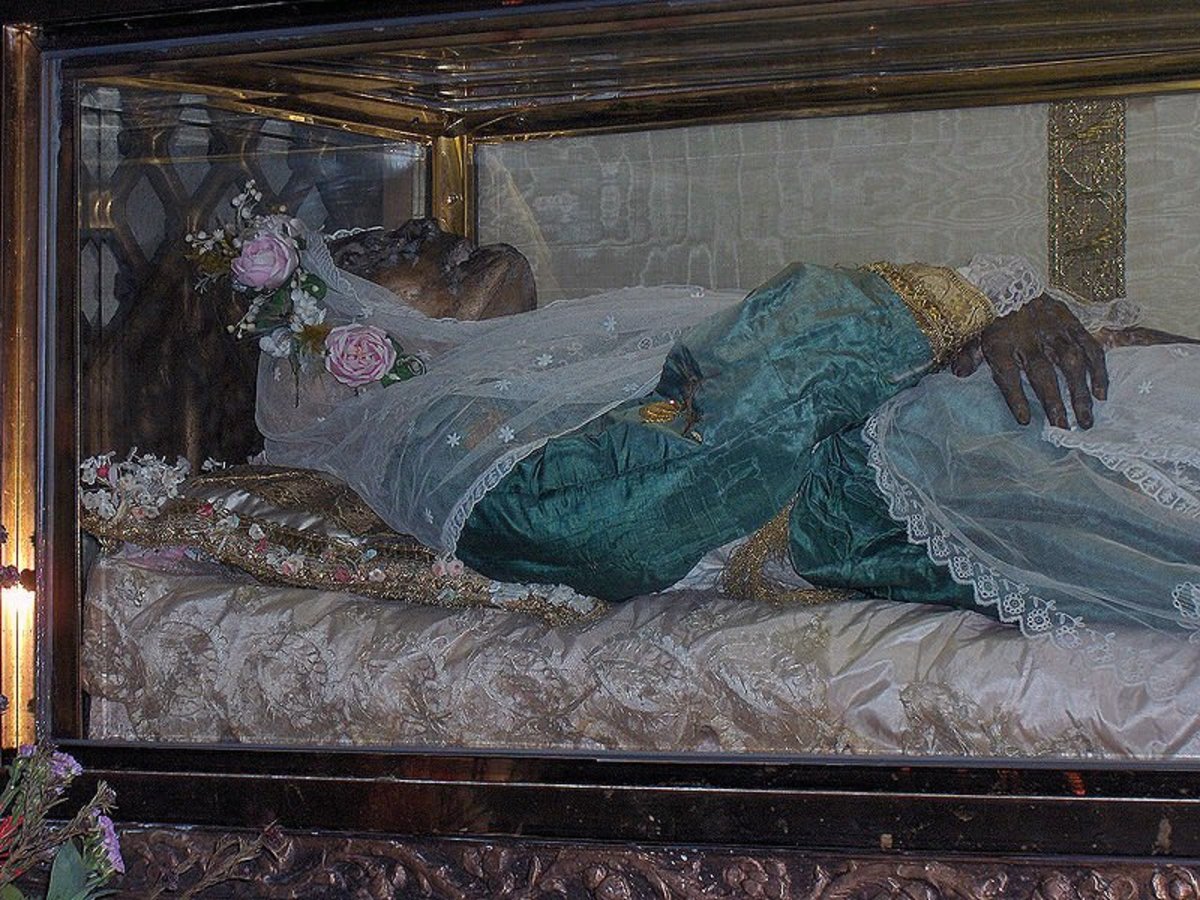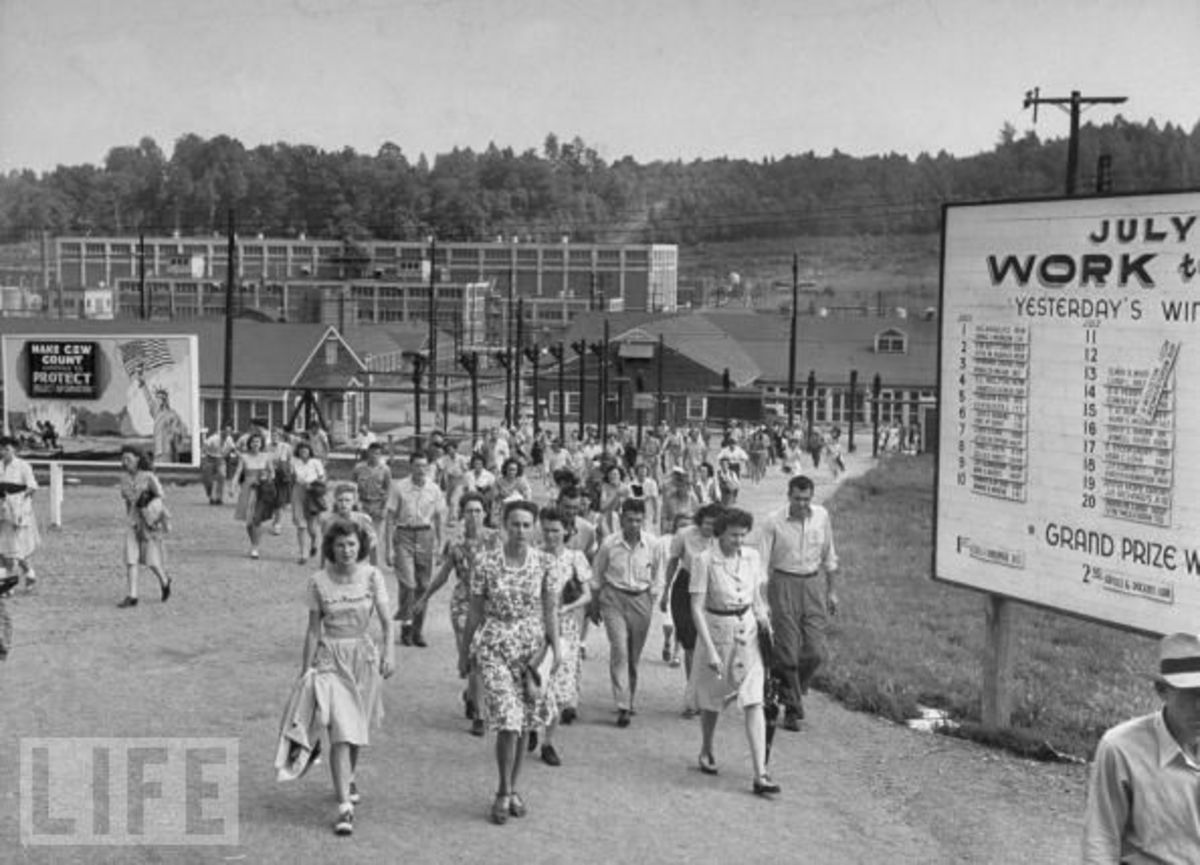Egyptian History
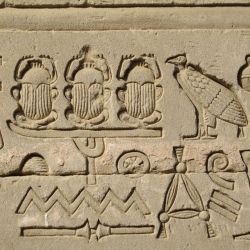
Egyptian Civilization
Ancient Egypt was the center of one of the world's oldest and greatest civilizations. Like Mesopotamia in southwestern Asia, ancient Egypt has been called a cradle of civilization. The kingdom of Egypt began to develop in prehistoric times along the fertile valley of the Nile River in northeastern Africa. For more than 3,000 years the kingdom survived rebellions and absorbed or drove out invasions of Asians and Africans. During one long period, Egyptian rulers controlled an empire that included northeastern Africa and much of southwestern Asia. Political and economic pressures gradually weakened Egypt, and it was conquered by Alexander the Great in 332 B.C. After that time, Egypt was almost always under foreign rulers, and Egyptian civilization steadily declined.
The story of ancient Egypt has been revealed through a branch of archaeology called Egyptology, which began in the 19th century. In the desert sands, Egyptologists have discovered villages, graves full of tools and ornaments, and monumental pyramids, temples, and statues. They have also found tomb paintings, inscriptions, and many texts. These remains give a vivid picture of Egyptian civilization. Scholars differ widely on dates within the civilization.
Introduction photo by Martyn E. Jones.
All photos used in this article are in the public domain unless otherwise noted, and even then, still used with permission.
Predynastic Egypt
Thousands of years ago, all of northern Africa is believed to have consisted of a fertile plain roamed by wandering hunters. In the eastern part of the region, the Nile flowed northward to the Mediterranean Sea. The river ran first through a long, narrow valley between cliffs, and then, as it neared its outlet, through a broad and flat terrain.
During the late Paleolithic period, or Old Stone Age, the average rainfall in northern Africa decreased, the temperature rose, and the fertile plain slowly began to turn into desert. The annual flooding of the Nile, however, built up a thick layer of rich black swamp soil along its riverbanks. There plant life thrived. Gradually, wild game moved from the increasingly arid plains to the fertile river valley, and prehistoric hunters followed the game. They had flint implements and crude pottery. Some of them may have worshiped a sun-god.
A bas relief showing Egyptian farmers with their cattle. The cattle did agricultural labor, and their dung was used for fuel.
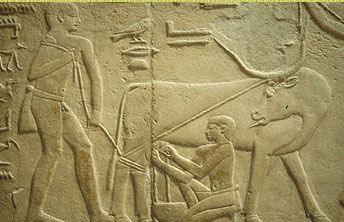
Early Settlers
The earliest inhabitants of the Nile Valley lived in small settlements scattered along the edges of the swamps, where they hunted game and gathered wild plants for food.
As time passed, the people discovered that after each yearly flood they could scatter seeds of wild barley and emmer wheat into the Nile mud for a rich harvest. They also discovered how to ensure a steady supply of meat by penning wild cattle and sheep into the curved bays formed by the cliffs that bordered the valley. These steps toward growing crops and raising animals brought the earliest Egyptians into the Neolithic period, or New Stone Age.
By 5000 B.C., Neolithic Egyptians were systematically farming the land along the Nile and had a fairly stable way of life. They were organized into clans, or groups of related families, and each clan was headed by a chief. Excavations in the Nile delta and in the Faiyum region farther south show that each clan lived in a walled village of flat-roofed rectangular huts made of mud and reeds.
Political and Religious Development
Egyptian government and religion were closely linked. Members of each village believed that their clan had been founded by a sacred animal. They tended to identify their first or most heroic chief with the sacred animal and portrayed the chief as having the animal's head. In time they came to think of this chief as a god, usually connected with some force of nature. For example, Horus, the falcon-headed god of Behdet in northern Egypt, was linked with the life-giving sun. Osiris, another god worshiped in the delta, was related to fertility.
Clan chiefs acted as priests in the worship of the forces of nature on which the crops depended, supervised agricultural work, and led military expeditions.
Through conquest and agricultural organization the stronger clan chiefs slowly united groups of villages or towns into clan states, later called nomes. The nomarch, or nome ruler, had great prestige and also great responsibilities. When the harvest was good, he was credited with magical power. When the harvest was bad, he might be killed by his subjects. To strengthen his authority, a nomarch imposed his clan god on the entire nome. The other villages of the nome did not give up their clan gods, but instead devised myths to explain their subordinate relation to the god of the nome.
Gradually, powerful nomarchs extended their authority beyond their nomes to become petty kings, and the people began to look upon them as divine. Sometime between 4500 B.C. and 3500 B.C. the leading rulers subdued their weaker rivals and consolidated their territories into two large kingdoms. Upper Egypt extended from Aswan in the south to the beginning of the Nile delta. Lower Egypt comprised the delta itself. Each kingdom had its own capital and government and a chief god. Horus of Behdet became the god of Lower Egypt, and Seth of Ombos dominated Upper Egypt. Later, Horus also became the chief god of Upper Egypt, possibly as a result of conquest. Upper Egypt eventually unified the two kingdoms, and Horus became the national god. However, the memory of the two original kingdoms survived and the country was always known as the Two Lands.
The Egyptians loved life and were encouraged by the continually renewed landscape of the Nile valley to believe that life continued after death. Osiris, god of fertility and the Nile, by extension became revered as the god of death and rebirth. The people believed that when the Nile was low, Osiris died, and that he was reborn and brought new life to the land when the waters rose again.
Belief in an afterlife led to increasingly elaborate burial customs among the Egyptians. In earliest times they simply wrapped the dead in skins or mats and buried them in shallow graves under their houses or in village cemeteries at the edge of the desert. Gradually the graves of rulers were dug deeper and covered with heaps of sand and rock as monuments. The sand preserved the bodies and the food, tools, and ornaments that were buried with them for use in the afterlife.
Economic and Technical Development
Throughout their history the Egyptians depended on the Nile for life. They increased their living space by building settlements on artificial mounds connected by causeways, and they increased their farming space by draining some of the marsh water through ditches into the dry sands away from the river. As time passed, they dug irrigation canals to save the floodwaters for the dry season and to carry water to fields far from the river, and they also built dikes along the river to control the floods. Irrigation vastly improved farm production. Later, the invention of the plow also increased production. In time, a small number of farmers could grow more than enough food for the whole population. As a result, many Egyptians were free to take up nonagricultural pursuits.
Some wove flax into linen cloth or coiled strips of clay to make pottery, which they fired red, black, or brown. Others ground and polished flint tools, hollowed out stone vessels with drills, or made necklaces by boring holes in shells and semiprecious stones. Particularly skillful workers carved scenes of men and animals on ivory combs and slate palettes. In the hollowed part of a palette, malachite was ground to make a green eye paint, called kohl, used by men and women. By 3500 B.C., metalworkers were casting copper tools and making ornaments of gold.
The manufactures of the craftsmen and the surplus production of the farmers encouraged the development of trade. At first, most trade was domestic. Local specialties were carried by boat from village to village along the Nile. In each boat stood a pole carved in the likeness of the clan animal of the village or nome from which the boat came. The boats were made of bundles of papyrus reeds. They were rowed downstream by seven or eight pairs of oarsmen and were probably towed upstream by donkeys, but by the beginning of the dynastic period the development of the sail, coupled with a prevailing north wind, made upstream travel much easier.
Donkey caravans carried most of predynastic Egypt's foreign trade, which consisted of Egyptian produce and manufactures exchanged abroad for needed minerals. From Sinai and the deserts in the east the caravans brought back malachite, copper, basalt, and gold. From Nubia in the south came gold, ivory, and myrrh.
In Red Sea ports, Egyptian merchants traded with Mesopotamians for seashells, lapis lazuli, silver, and obsidian. Under Mesopotamian influence the Egyptians after 3500 B.C. built wooden ships with square sails for sea travel. They brought cedar logs from the area later called Phoenicia and olive oil from Palestine.
Because the annual rise and fall of the Nile regulated their farming activities, the Egyptians used the river as a basis for their earliest measurements of time.
Their division of the year into the three seasons of flood, planting, and harvest later developed into a Nile calendar. For nonagricultural affairs, such as religious festivals, a calendar based on the regular appearance of the moon slowly came into use. A period of 12 lunar months roughly coincided with the Nile year. During this period the Egyptians developed a simple form of writing in which a picture stood for the object it portrayed. By about 3100 B.C. certain picture signs were being used to mean not only the thing shown but also something closely related to it, and later something that merely sounded like the thing shown. Eventually the scribes could write longer words or more abstract ideas by spelling them out, even using what could be considered alphabetic signs. This was all the easier because the Egyptian wrote no vowels, only consonants, so a group of two or three consonants could be u sed to write several different words. In order to indicate which of these words he meant, the scribe usually added a picture sign of the type of object he intended, which modern scholars call a determinative, because it helps to determine the sense. Such picture writing is called hieroglyphic. Throughout Egyptian history, hieroglyphs were used almost entirely for the royal and religious inscriptions that were carved on stone tombs and other monuments.
After a time, priests and scribes developed a simpler, speedier version of hieroglyphs, called hieratic writing. This form was used for government and business records, letters, and eventually literature. Many centuries later, by about 700 B.C., an even speedier form, called demotic, began to be used in business matters. Both hieratic and demotic were written with a reed pen on leather or on sheets made by pasting together two layers of flattened, interwoven papyrus stalks. The sheets of papyrus, from which the English word "paper" derives, could be pasted end to end and rolled in scrolls. The discovery of the Rosetta stone, a basalt slab with the same text in hieroglyphic, demotic, and Greek, gave scholars the key to hieroglyphics.
Photo by Irum Shahid
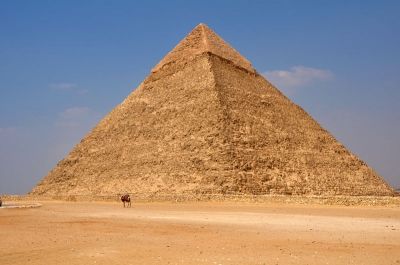
Early Dynasties and Old Kingdom
According to tradition, a king of Upper Egypt, named Menes, conquered Lower Egypt in about 3100 B.C. By gathering the nomes under his rule, he established the first Egyptian dynasty, or royal line of rulers. His capital was Memphis. To symbolize his authority over both lands, he wore a double crown composed of the white crown of Upper Egypt placed over the red crown of Lower Egypt.
Menes and his successors of the first and second dynasties created a unified Egyptian culture. It reached its height in the Old Kingdom, from the rise of the third dynasty in about 2700 B.C. to the fall of the sixth dynasty in about 2200 B.C.
Old Kingdom achievements in government, religion, and many arts were never surpassed in later Egyptian history.
Power of the Pharaoh
A strongly centralized government controlled by the ruler characterized the early dynasties, and the Old Kingdom. The ruler was so revered that Egyptians rarely presumed to mention his name. Instead they referred to him as "his majesty" or spoke of the "pharaoh," meaning his great house or palace.
Much later, "pharaoh" became the title of the ruler. To strengthen political unity, the early pharaohs promoted the idea of the pharaoh as divine. The rulers claimed to be incarnations of Horus, the national sungod. They also identified themselves with another Horus, the son of Osiris, and believed that when they died, they would become Osiris and would continue to watch over their people.
The pharaohs of the Old Kingdom had absolute authority in every area of life. A pharaoh led armies, administered justice, and acted as high priest. He owned all the land and had the last word in agricultural affairs. He directed royal building projects, including vast irrigation works, palaces, and temples. He received crops and other goods as taxes. These were stored in warehouses that also belonged to the ruler.
The pharaoh derived further wealth from his control of mining and trade. From the first dynasty on, pharaohs sent groups of laborers to work the copper mines in the Sinai peninsula. Similar expeditions probably mined gold in the eastern deserts. Whatever tax goods a pharaoh did not need for the expenses of the government, he sold at home or abroad, taking a percentage of every transaction. The goods usually included wheat, copper, linen, stone vases, papyrus, and other manufactured products. They were traded in Asia for semiprecious stones, in Libya and Crete for olive oil, and in Nubia, the Sudan, and Punt (modern Somali) for ebony, ivory, ostrich feathers, gold, and myrrh. The pharaohs established a colony of Egyptian merchants at the Phoenician port of Byblos to stimulate trade.
Egyptian Bureaucracy
The pharaoh was assisted by a well-organized bureaucracy, or hierarchy of officials. Directly under him were two viziers, or chief ministers, to symbolize the two kingdoms. The viziers served the pharaoh as personal advisers, doctors, chief architects, librarians, and chief justices. They also had charge of the essential tasks of constructing and maintaining the irrigation works. Each vizier was aided by a chancellor, whose main task was to supervise taxation and the treasury.
The pharaoh was also assisted by a minister of public works, a military leader, and other officers, usually chosen from the royal family and nobility. They formed the royal court and were known as Honored Ones. They looked after the pharaoh's personal needs and ran the palace. There were also many priests, who administered the temples.
Under the court officials were the nomarchs, who governed the 22 nomes of Upper Egypt and the 20 nomes of Lower Egypt. They were members of the provincial aristocracy, theoretically dependent on the pharaoh because they owed their appointments to him.
In practice, nomarchs far from the capital governed as they pleased and usually bequeathed their positions to their sons. Still lower in the hierarchy of government was a vast army of irrigation and building supervisors, bookkeepers, tax collectors, messengers, and scribes.
Wealth and privilege made the life of officials very different from that of the lower classes. But in the Old Kingdom, Egyptian society had great mobility and an ambitious man of any class might become an official.
The keys to success in government were knowledge and skill and the ability to write. At a scribe's school the son of a noble or even a peasant could learn to write, memorize standard texts, and keep accounts. Then, after paying a fee to the government, the young man could become a mi.nor official. As an official he was free of taxes and forced labor. With ability, tact, and luck he might eventually become a chief minister.
The Egyptian of the Old Kingdom was characteristically an optimistic, vigorous person whose chief goal was material success. The merit system of advancement enabled him to achieve his goal. Hard work, by which he might advance, was esteemed as a virtue.
The young were taught to cultivate this virtue. In the text Instruction of the Vizier Ptahhotep the vizier urges his son to work to get ahead, both for the virtue of work and for the material rewards it will bring.
Life of the Nobles
The nobles of the materialistic Old Kingdom surrounded themselves with luxuries. Wall reliefs, paintings, and objects found in tombs give details of the rich and comfortable existence of a noble, priest, or other high official. The luxurious estate of a noble usually consisted of a large walled garden, which contained flowers, trees, and pools and surrounded a spacious, airy house. The house was built of mud brick over a wood frame, with courtyards, porticoes, small latticed windows under the eaves, and sometimes a second story. An outside staircase led to a flat roof shaded by awnings, where the family spent time enjoying the cool breeze from the river.
Houses had as many as 30 rooms, including bedrooms, baths, an open reception court surrounded by a colonnade, and a large hall filled with pillars. The main rooms were often gaily decorated, with blue ceilings and paintings of birds, plants, animals, and water scenes on the walls and floors. In the rooms were leather-cushioned chairs of wood with ivory inlay, gold overlay, and carved animal feet. There were also tables, beds, storage boxes, hangings, copper vessels, and oil lamps.
Nobles usually wore a knee-length kilt of white linen with a triangular flap in front. They clipped their beards and hair and in later periods shaved them. Sometimes a noble wore a false beard for dignity. His wife's costume was a close-fitting ankle-length linen skirt with broad bands over the shoulders. Both men and women wore heavy curled black wigs, held in place by a decorative band, to protect their heads from the sun. On festive occasions they placed cones of perfumed grease on top of their wigs. Their costumes were enriched by wide jeweled collars, armbands, and sandals. In later times, pleated transparent linen capes and skirts were added to the costume. Women rouged their lips with the help of hand mirrors and stained their fingertips red.
For pleasure the nobles hunted lions and ostriches in the desert or took their wives on short trips to hunt birds. They traveled by boat on the Nile or on irrigation canals, or servants carried them in litters alongside the water. At home the nobles read papyrus scrolls in their libraries or played games, such as one similar to checkers. Both men and women enjoyed elaborate banquets. Their diet included soup, roast beef, mutton, goat, goose, fine wheat bread, lettuce and other vegetables, figs, grapes, and dates, and honey cakes. They drank large quantities of beer and wine. While the nobles feasted, they were entertained by dancing girls and musicians, who played harps, flutes, and clappers.
Life of the Common People
The great mass of Egyptians were peasant farmers and craftsmen, who lived in villages of little houses clustered about villas of noblemen. Their one-room huts of reeds and mud and their rectangular mud-brick and wood houses were crowded together so that none of the precious farmland would be wasted. The peasants labored from dawn to dark, planting, irrigating, and harvesting two crops a year. Both men and women wore a rough linen kilt, which they discarded while working in the hot sun. Their basic crop was wheat. They also raised barley and flax, tended vineyards, and kept cattle, which they rounded up yearly to fatten and brand.
As the government became more centralized under the early dynasties, the peasants lost their freedom and became legally bound to perform special tasks on the estates of the pharaoh, nobles, or priests. Between harvests, when the fields were covered by the Nile flood, the government drafted work parties of 50 to 100 peasants. They labored in the royal mines and quarries, maintained the irrigation system, built temples and tombs, and went on trading and military expeditions. At such times they were housed and clothed by the government and fed from government warehouses. Workers on royal projects were lodged in low mud-brick barracks, and were checked in and out by gatekeepers.
Craftsmen worked in shops near the nobles' villas or the pharaoh's palace. Most of them inherited their crafts and went through a long apprenticeship. They were organized into groups of five or ten men under a foreman, who distributed raw materials and paid them in food and clothing. Potters made fine clay jars and bowls on a potter's wheel and baked them in very high, closed ovens. Stoneworkers made jars of diorite, alabaster, and other stones. Skilled workmen ground the stone vessels to translucent thinness. Smiths made copper and bronze tools and dishes and intricate gold necklaces set with lapis lazuli, turquoise, and carnelian.
Weavers produced rich hangings and awnings, and linen as fine as silk.
The houses of the common people were furnished with a few reed mats, wood stools, and clay dishes. At meals they ate wheat or barley bread, supplemented by fish and vegetables such as beans, onions, radishes, and cabbage, and washed down with beer. The people, like their masters, loved pleasure. They sang at their work, and they played games and told legends in their leisure time. At frequent religious festivals, which provided their most exciting recreation, they danced and gorged at feasts provided by the estate owner.
National Religion
The common people continued to worship their local gods and Osiris, who also remained an important symbol of the pharaohs. However, the priests of Heliopolis, near the capital city of Memphis, encouraged the worship of the sun-god Re, or Ra. They claimed that Heliopolis, the city of the sun, was the place where the world was created and that Re was the creator. To win popular support, they linked the story of Osiris and his family to Re. According to the Heliopolitans, in the beginning there were only the waters of chaos, called Nun. On a hillock of land above the waters, Re, or Re-Atum, created himself. He then created the god of the air, Shu, and the goddess of moisture, Tefnut. They produced the god of earth, Geb, and the goddess of the sky, Nut. Geb and Nut in turn gave birth to the couple Osiris and Isis and the couple Seth and Nephthys. This family of gods is known as the great ennead, from the Greek for nine.
The Heliopolis doctrine was an early attempt to organize many gods into a system in which one god was the source of the universe. The doctrine may have been formulated by the Heliopolitans in an effort to dominate the Old Kingdom pharaohs and their priests at Memphis. The Memphis priests countered with the Memphite Theology, which claimed that Ptah, patron god of Memphis, had created all the gods including Re. The Memphite Theology reached a philosophical height that the Egyptians never again approached. However, Re finally became the official god of Egypt.
The pharaohs added "re" to their names, as in Khafre and Menkaure. They called themselves the sons of Re and from that time shared their power with the priests of Heliopolis. According to tradition a dead pharaoh became Osiris or Re, bailed out Re's sun boat as it crossed the sky, acted as Re's scribe, or even took over Re's throne and devoured other gods.
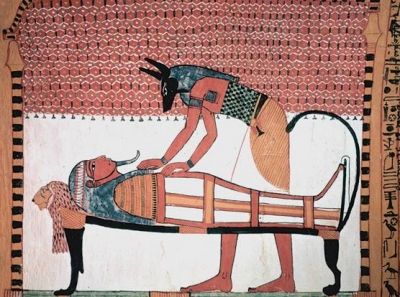
Funeral Art
Egyptians of the Old Kingdom also believed that after a pharaoh died, his ka, or life force, often returned to the dead body to enjoy further life.
The body, therefore, had to be preserved, which was done by embalming. The pharaohs built elaborate tombs to protect their bodies forever for the ka's return.
Mastabas
Cemeteries at Thinis, better known as Abydos, and at Sakkara, near Memphis, are crowded with the ruined tombs and cenotaphs of the pharaohs of the first three dynasties. These structures were large, rectangular, mud-brick monuments called mastabas.
The sides sloped inward at the top, possibly in imitation of the sloping cliffs along the Nile, and the bricks formed decorative recesses in imitation of the facade of the pharaoh's palace. A brick-lined shaft in the mastaba led to an underground burial chamber, which held the pharaoh's mummy, or chemically preserved body, wrapped in resin-soaked linen. Servants of the dead pharaoh were killed and buried with him, to share his immortality and continue their service in the afterlife.
Pyramids
The mastabas were the forerunners of the famous pyramids. In the third dynasty the vizier Imhotep piled six limestone mastabas of diminishing size one on top of the other to create the step pyramid at Sakkara. This was done for the pharaoh Zoser. Three great pyramids were erected by the fourth-dynasty rulers Khufu (Cheops), Khafre, and Menkaure on the rocky plateau of Giza, near modern Cairo. Better constructed than the many later pyramids, this group is one of the Seven Wonders of the Ancient World. Each required many years of labor and a large part of the country's riches. According to the Greek historian Herodotus, it took 100,000 men 20 years to build the massive pyramid of Khufu.
Pyramids were built of huge blocks of limestone, the largest weighing as much as 30 tons. The stones were mined, transported, shaped, and set in place with the aid of simple stone and copper tools, rafts, ropes, wood sledges, rollers, and levers. Deep inside each massive structure was a burial chamber inscribed in the fifth and sixth dynasties with magic formulas called Pyramid Texts. To help the pharaoh's ka find the body to which it belonged, the mummy was painted to resemble the pharaoh as he had looked in life, and a large stone statue of him stood in a special burial chamber known as the serdab. In the pyramid were also treasure chambers containing food, ointments, jewelry, and other objects to be used in the afterlife.
Near the pharaoh's pyramid stood a smaller one for his wife and a whole street of mastabas for his nobles, who were rewarded for their loyalty and services to the king by the gift of a tomb near his.
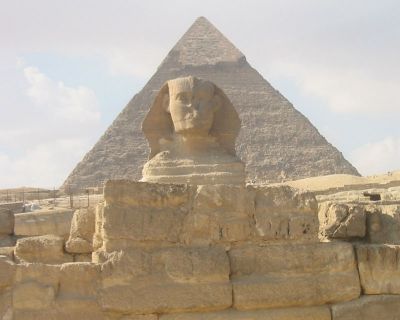
Temples
Connected to each pyramid was a limestone mortuary temple, where priests made offerings of food and drink to the pharaoh's ka and to which a long covered causeway led from the edge of the river. A temple usually included colonnaded courts, storerooms, and chambers for the altar and for statues of the pharaoh. The plants used in building prehistoric palaces were copied in columns of limestone or red granite. Some represented palm trees, while others were fluted to suggest bundles of papyrus reeds and had capitals shaped like lotus buds or papyrus flowers . Brilliantly painted bas-reliefs covered the interior temple walls. They showed farming, hunting, garden, and banquet scenes to help the pharaoh's ka enjoy earthly pleasures after death. The artists drew stiff, flat figures without perspective and made the pharaoh much larger than anyone else to show his importance.
Apart from mortuary temples only a few temples are known that are dedicated to the regular worship of the gods in the Old Kingdom. The most distinctive are the sun temples dedicated to Re with the cult image in the form of a massive pointed stone shaft or obelisk.
Practical Sciences
The Egyptians developed scientific skills for very practical purposes. Because the annual Nile flood washed away all boundary lines, they invented enough arithmetic and geometry to redraw them. Engineers used mathematical skills to design the pyramids and temples. Officials used mathematics to calculate taxes or to measure the amount of wheat in a government granary. Arithmetic handbooks show that the Egyptians used the decimal system, with different symbols for 10, 100, 1000, and so on. Digits were shown by the required number of strokes. For example, 103 would be expressed by the symbol for 100, plus three strokes. They used fractions, especially if the numerator was 1. Multiplication problems were solved by a series of additions. For instance, to multiply 8 by 7, the Egyptians added two 8's, two 8's, two 8's, and one 8 to equal 56, or seven 8's. They divided figures by a similar method.
For greater accuracy in keeping government records the Egyptians of the early dynasties improved their measurement of time. Noting that the 12 lunar months did not quite equal the year as measured by the annual Nile flood, they devised a calendar that combined elements of the Nile and lunar systems. They first adopted a year of 360-days divided into 12 months of 30 days each. By observing the annual rise of the Dog Star, Sirius, on the eastern horizon, the Egyptians discovered that they needed 5 more days to equal the solar year. They therefore added 5 extra days to the last month of their year, which corresponded to the modern September. Many centuries later, in the Ptolemaic period, they added a leap year to achieve a more accurate solar calendar.
The Egyptians also developed medical knowledge. Although most of their medical texts treat illness as supernatural in cause and cure, some show an understanding of the body, probably gained from the practice of embalming the dead. A document called the Edwin Smith Surgical Papyrus, named after its discoverer, contains the idea that the heart is the source of the body's life and influences the rest of the body. The text also describes various kinds of bone fractures and suggests rest, diet, surgery, and various medications. Other texts show that there were Egyptian specialists in ailments of the eyes, teeth, and internal organs.
Decline of Royal Power
The pharaohs' wealth and authority reached a peak in the fourth dynasty and began to decline after about 2500 B.C. The building of tombs and temples drained the royal treasury and consumed much labor without contributing to the welfare of the country. Also, less money came in from taxes, because the pharaohs gave the priests large gifts of tax-free lands. Finally, fees formerly paid to the pharaohs by the men they appointed to office were lost as more and more nobles passed their estates and offices directly to their sons. As a result of the pharaoh's loss of power, the priests of Heliopolis began to rival him, and ambitious nobles freed themselves as much as they could from royal authority. The kingdom of Egypt therefore declined in strength, and by the middle of the sixth dynasty it had degenerated into a loose federation of feudal territories.
During the following centuries, known as the First Intermediate Period, Egypt remained in a state of political chaos. The weak seventh and eighth dynasties lasted only about 25 years. The ninth and tenth dynasties at Herakleopolis controlled central Egypt, but the nomarchs of Thebes in Upper Egypt contested their authority. Nobles refused to pay taxes, with the result that the irrigation system fell into disrepair. Nobles attacked one another, robbers pillaged estates and tombs, and there were peasant rebellions. Such internal weaknesses left the delta unprotected against wandering Semitic tribes from Asia.
In spite of political decay, the ninth and tenth dynasties saw the appearance of an Egyptian literature.
Most of it expresses dismay at the social unrest and the destruction of traditional values. One text states : "The rabble is elated and from every city goes up the cry: 'Come! let us throw out the aristocrats.'"
Two prophets describe the collapse of government and law, lament the suicides who throw themselves to the Nile crocodiles, and blame all the trouble on the pharaoh.
A harpist advises men to enjoy the pleasures of the moment since no one knows what happens after death.
A peasant who has been robbed by a court official appeals for justice in a letter to the chief steward and denounces him for not protecting the people.
Middle Kingdom
In about 2150 B.C., after years of struggle with the rulers at Herakleopolis, the powerful nomarch of Thebes claimed the title of pharaoh and established the 11th dynasty. By 2050 B.C. the dynasty's greatest ruler, Nebhepetre Mentuhotep, had defeated Herakleopolis and had won control over all Egypt. His victory marks the beginning of the Middle Kingdom, which lasted until 1800 B.C. The 11th dynasty ruled from Thebes, and the 12th dynasty established its capital at Lisht in the Faiyum, a lowland west of the Nile south of Memphis.
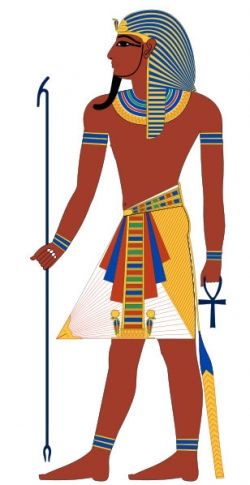
A New Idea of Kingship
The social and political unrest of the preceding period tended to limit the power of early Middle Kingdom pharaohs. Their position was threatened by nobles and priests. Furthermore, they were weighed down by social responsibility, and they tried to live up to the popular idea that they were good shepherds who owed justice to all. They often added the word ma'at, meaning justice, to their names. Statues of the pharaohs show faces lined with care. A letter from Amenemhet I expresses his loneliness, his labors for his people, and their ingratitude.
The early Middle Kingdom pharaohs constantly strove to increase their authority. They devised the first census for the purpose of taxation. They built a national army, appointed royal judges in the nobles' courts, and sent out royal agents, called the Eyes and Ears of the King, to report to them on conditions in the realm. These measures pleased the people by protecting them from oppression by the nobles and from disorder. Little by little the nobles began to accept a stronger central government. By the later 12th dynasty the pharaohs had regained a measure of power, although they never became as autocratic and awe-inspiring as those of the Old Kingdom.
During the course of the Middle Kingdom, Egypt became increasingly prosperous. The pharaohs, particularly Amenemhet III, spent large sums to construct in the Faiyum a reservoir of floodwaters that would irrigate much additional land. They improved navigation on the Nile by cutting a canal around the rapids of the First Cataract. They built forts and garrison towns along the Nile, including the Wall of Amenemhet the Justified, beyond the Third Cataract. As a defense against Semitic invaders they constructed a line of forts in Sinai, known as the Wall of the Ruler.
With the profits from their trading ventures the pharaohs undertook great building projects. The most impressive were the temples of Amon at Thebes, including the famous temple at Karnak (now a village on the site of Thebes). Amon was the local city god, whom the pharaohs identified with the national god Re. The two gods were combined into Amon-Re, the dominant official god, except for one brief period, for the rest of ancient Egyptian history.
The failure of the early Middle Kingdom pharaohs to reestablish full autocratic authority meant that their nobles retained a sizable amount of power. The nomarchs and other great nobles kept their lands, maintained private mercenary troops, supervised irrigation and the law-courts, and collected taxes. Official dates were reckoned by the reign of the local nomarch as well as by that of the pharaoh. With increased economic and political power the nobles soon began to usurp the pharaoh's exclusive claim to immortality. They carved impressive tombs in the cliffs west of the Nile, inscribed with Coffin Texts like the royal Pyramid Texts.
The rise of the upper class indirectly improved the situation of the ordinary Egyptian. To win popular support against the nobles, the pharaohs gave commoners land as a permanent possession. The peasant thus became a freeman, who could buy and sell land or work as a free artisan or scribe. In theory, peasants could even win immortality by having buried with them tablets inscribed with the proper magic texts.
The breakdown of class privilege is reflected in one important Egyptian text, which goes so far as to proclaim the equality of all men. The creator god is quoted as saying : "I made the four winds that every man might breathe thereof.... I made the great flood waters that the poor man might have rights in them like the great man.... I made every man like his fellow."
Middle Kingdom Literature
The Middle Kingdom was the golden age of Egyptian literary achievement. Tales of adventure, such as the Story of the Shipwreck and the Story of the Two Brothers, were especially popular. The most famous is the Story of Sinuhe, a romanticized account of an Egyptian noble, which illustrates the pride of the Egyptians in their country and ruler. There were also religious poems in a style similar to that of the later Old Testament and many songs of laborers and lovers. The drama of the life, death, and rebirth of Osiris was performed at a festival once a year.
Details of Egyptian character and family life are found in letters written from Lower Egypt by a shrewd and stingy noble, Hekanakht, to his eldest son, who was at home in Thebes. In these letters, Hekanakht instructs the young man to deal harshly with tenants and servants and to take good care of the family.
Hyksos Invasion
Conditions again became chaotic in the Second Intermediate Period. The pharaohs of the 13th dynasty lost their power, and the nobles again plunged the country into civil war. Taking advantage of Egypt's internal weakness, Hurrians and Semitic warriors, called Hyksos, invaded the delta. By 1720 B.C. they had set up the 15th dynasty at Avaris. The Hyksos owed much of their success to bronze swords, strong compound bows of wood, sinew, and horn, and especially horses and war chariots. These weapons were all new to the Egyptians.
Although the Hyksos adjusted themselves to Egyptian ways and demanded only tribute from the princes at Thebes, the Egyptians detested them. The Egyptians gradually adopted the weapons of the Hyksos and turned them against the invaders. The last two pharaohs of the 17th dynasty at Thebes began a campaign to drive the Hyksos out.

Empire, or New Kingdom
The Empire, sometimes called the New Kingdom, began with the accession of Ahmose I in 1574 B.C. It was a 400-year period of territorial growth and prosperity.
It was also a time of rigid government controls, during which the Egyptian people lost much of the freedom they had gained during the Middle Kingdom. Conquest and Reorganization. Ahmose I, the first pharaoh of the 18th dynasty, set the military tone of the empire by driving back the Hyksos all the way to a city in Palestine, where he conquered them after a three-year siege. Fear of the Hyksos' return and of invasion from the south by Nubia led the successors of Ahmose to form a policy of aggressive imperialism.
Amenhotep I extended Egypt's frontiers south against the Nubians to the Third Cataract of the Nile. Thutmose I continued making conquests in the south and also campaigned in Asia. Peaceful commercial expansion was encouraged by Queen Hatshepsut, who exploited the Sinai mines and sent a large trading expedition to Punt. Her warlike successor, Thutmose III, launched an official policy of military conquest that has led modern scholars to call him the Napoleon of Egypt. With an efficient professional army he created an empire that stretched southward to the Fourth Cataract in Nubia, northward to the Nile delta, and eastward through Palestine, Phoenicia, and Syria to the Euphrates River.
To maintain control over so many different lands, Thutmose established a commissioner and a small garrison in each major town and sent out annual military patrols. He brought the sons of captured princes as hostages to Egypt, where they received an Egyptian education and took Egyptian wives. Riches poured into the Egyptian capital of Thebes in the form of war spoils, tribute, and gifts from defeated kings seeking favor. As a result, the central government at Thebes became even more powerful. Egyptian trade expanded into the new territories, and thousands of foreign slaves were brought into Egypt as a cheap labor force.
The use of slaves, however, actually damaged the welfare of the Egyptian people. Slaves of the laboring class worked on royal building projects and served in the army, two activities that had formerly supported a large part of Egypt's workers. Also, many better educated slaves became servants of the king or his nobles. Pleasure-loving nobles were glad to hand over their responsibilities to capable slaves, who soon filled many military and civil offices. Consequently, lower class Egyptians found fewer opportunities to rise into the official class than they had during the Old Kingdom. The peasant sank lower and lower on the social and economic scale and became silent and submissive.
The rise of the empire witnessed an enormous development of the priesthood, especially that of Amon, the state god of the period. Religion became a profession, instead of the part-time occupation of nobles and officials that it had been in the Old and Middle kingdoms. The enormous wealth poured into the temple treasuries by the kings after victories abroad gave the priests great economic and political power. The very succession of the kings could be influenced or decided by divine oracles. The masses felt that their poverty must be the result of sin, and they looked to the gods and to the life after death for redemption and happiness.
An exception to the restrictive social trend of the time was a marked improvement in the status of women. Records indicate that women could inherit property, buy and sell land, and give evidence in court. Amenhotep III and his son, Ikhnaton, represented their queens in statues as large as their own. Queen Hatshepsut ruled in her own right. A number of technological developments occurred during the period of empire. One of the most striking was the development of techniques for making glass vessels. Liquid glass, often of a brilliant blue, was put as a glaze on vessels of steatite, a soft stone.
Tombs and Temples
The pharaohs of the 18th, 19th, and 20th dynasties spent much of the vast wealth from their conquests to build tombs and temples. Because the pyramids of earlier periods were frequently broken into by robbers, the Empire pharaohs carved more secure tombs out of the rock cliffs at several points along the Nile. The most famous of these are in the Valley of the Kings across the Nile from Thebes.
Important courtiers built smaller tombs in the cliffs along the river. From a tomb entrance, which was often hidden, staircases and corridors led deep inside the cliffs to treasure-filled rooms and to great, pillared h alls that contained statues of the dead. The ruler's coffin also reposed in the hall or in a burial chamber under the hall. The plastered walls of the corridors and rooms were decorated with painted scenes of daily life and the journey of the soul to the court of Osiris. The walls of later tombs were inscribed with charms from the Book of the Dead and other texts to help the soul answer the questions of Osiris. Best known among the tombs of the Valley of the Kings is that of Tutankhamen, discovered in 1922. The many treasures and other objects buried with Tutankhamen gave scholars much information about the 18th dynasty, in which he reigned.
The pharaohs also built mortuary temples to glorify themselves and temples to honor the gods. These temples elaborated on the traditional styles of the Old Kingdom. They were huge in size but cheaply constructed.
Usually an avenue, lined on both sides with statues of lions with human or rams' heads, called sphinxes, led up to the main entrance in the temple wall. Bright banners hung from flagstaffs in front of a pylon, or monumental gateway with twin towers narrowing toward the top. Behind the pylon lay an open court with a colonnade on both sides, where the people watched public ceremonies. Behind the court only priests could pass through successive pylons to a gloomy hypo style hall and then to a small dark sanctuary chamber containing a statue of the pharaoh or god. Other small rooms for supplies or ritual surrounded the sanctuary.
The state Temple of Amon at Karnak had been extended ever since the Middle Kingdom to include acres of courts, pylons, chapels, and obelisks. Thutmose III did much of this building, and he covered the work with inscriptions recording his conquests. A later pharaoh, Rameses II, added the Great Hypostyle Hall, filled with columns that were almost 70 feet high and shaped like flowering papyrus stalks.
A mile-long avenue connected the temple at Karnak to another elaborate temple built at Luxor by Amenhotep III. Across the Nile at Deir el Bahri was the more delicate mortuary temple of Hatshepsut. In it, long ramps led to two colonnaded terraces built against the cliffs and surrounded by gardens of spice trees imported from Punt. Many more mortuary temples were crowded along the cliffs near the Valley of the Kings. Before the Temple of Amenemhet III sat two gigantic statues of the pharaoh, each weighing 700 tons. The Rameseum, built by Rameses II, had four colossal statues of Osiris against its facade. Four statues of Rameses adorned the entrance of his temple to Amon, cut into the Nile cliffs at Abu Simbel between the First and Second cataracts.
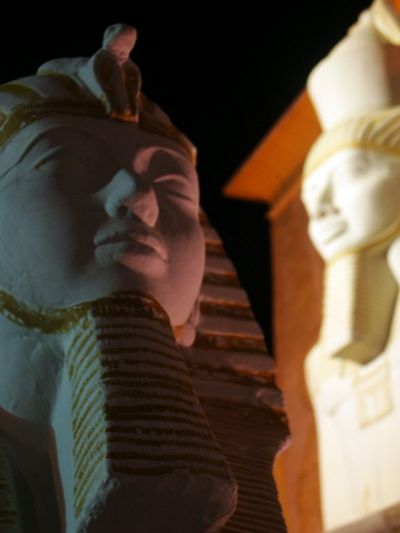
Amarna Revolution
During the Empire period a major religious controversy developed in Egypt. The mystical pharaoh Amenhotep IV of the 18th dynasty rebelled against the state worship of Amon and the political power of Amon's priests. He demanded that all Egypt recognize only the god Aton, or Aten. The pharaoh's agents closed the temples of Amon, disbanded his priests, and scratched his name from all monuments. Amenhotep changed his own name to Ikhnaton, meaning "he who is beneficial to Aton."
He abandoned the traditional capital city of Thebes and with his beautiful wife Nefertiti moved to a new capital, called Akhetaton, known now as Tell el Amarna.
There he devoted himself to his new religion. Aton's symbol was the blinding sun, and no idols were ever made to represent him. Such an abstract god had little appeal to the Egyptian people. They were used to personal gods, such as Osiris, whom they could understand and whose images they worshiped.
The Amarna religion produced many changes in Egyptian architecture. For example, the temples of Aton at Akhetaton had no dark secret chambers housing idols, but were simply courts open to the sun. Also, painting and sculpture became more realistic than before. Ikhnaton himself is portrayed with such human features as sloping shoulders and full thighs, rather than as a perfect or idealized god-king. Instead of being depicted leading battles, as portraits present the warlike Thutmose III, Ikhnaton is shown sitting in a cushioned chair opposite his queen, playing with their small daughters.
Decline of the Empire
While Ikhnaton was absorbed with his new religion, the eastern boundaries of the empire began to crumble under pressure from the Hittites in Asia Minor. Many Asian princes were feuding with one another and breaking their allegiance to Egypt. The Tell el Amarna letters, more than 300 clay tablets found by archaeologists at the site of the pharaoh's capital, contain messages from royal princes begging Ikhnaton to send troops to defend the kingdom. Ikhnaton made no reply.
Ikhnaton's successors, urged by the powerful priesthood, restored the worship of Amon and a military policy, but it was too late to save the empire. The 19th dynasty pharaohs Seti I and Rameses II tried to bring back order in Egypt's Asian possessions but could not defeat the Hittites. Then the Nile delta was invaded by waves of migrating Libyans and by wandering groups of raiders from Europe and western Asia, called Sea Peoples. Rameses III defeated them and took many captives, but internal troubles weakened his kingdom. Wars and great building projects were emptying the royal coffers, and workers and soldiers refused to work because there was not enough tribute coming in from the decaying empire to pay them. Rameses' successors, who were priests of Amon, abandoned the Middle East to the Sea Peoples, and this withdrawal brought the empire to a virtual end.
Late Period and Foreign Domination
During the Late Period, Egypt suffered collapse and anarchy. Nubia broke away from Egyptian rule and Libyans replaced Egyptians in high office. About 950 B.C. a Libyan named Sheshonk became pharaoh and established the Libyan 22nd and 23nd dynasties. By the 25th dynasty the Nubians had achieved royal power in Egypt. They were driven out by an invading Assyrian army in 671 B.C.
The Assyrians appointed as a vassal governor the local ruler of Sais, a city in the delta. His son Psamtik drove out the Assyrians and established the 26th dynasty, called the Saite, under which Egypt recovered considerable power. Economy and trade picked up. The pharaohs cut a canal from one of the mouths of the Nile to the Red Sea to open a shipping route from the Mediterranean Sea to the Persian Gulf. However, the Saite aroused the resentment of many Egyptians by employing foreign mercenaries. A disunited Egypt was conquered by the Persians in 525 B.C. and remained part of the Persian Empire for the next 200 years.
In 332 B.C. the Egyptians welcomed the conqueror Alexander the Great as their liberator from Persian rule. Accepted as the son of Amon, he founded the city of Alexandria before continuing his conquests farther east. After Alexander's death in 323 B.C., Egypt came under the control of his general, Ptolemy, who founded a dynasty that ruled for 300 years. Greek settlers lived peaceably with Egyptians, and the Ptolemies made Alexandria a great center of Hellenistic art and learning. However, Egypt again declined because of economic problems, dynastic intrigues, and weak and vicious rulers. The last Ptolemy, Cleopatra VII, for a time averted Roman annexation by her influence on the Roman leaders Julius Caesar and Mark Antony. In spite of her efforts, Caesar's heir, Octavian, added Egypt to the Roman Empire in 30 B.C. Egypt was strictly administered as a Roman province.
Rome imposed heavy taxes on the Egyptians and placed Greek and Roman citizens in positions of authority. At the same time, Christianity gradually replaced the old Egyptian beliefs. Coptic, the Egyptian language written with the Greek alphabet, replaced the earlier Egyptian forms of writing.
Under the Eastern Roman, or Byzantine, Empire, Egypt suffered from continued heavy taxation and from rules that barred any changes of occupation. The Christian Egyptians, objecting to religious control by the emperor, separated from the Church. Weakened by centuries of domination and strife, Egypt fell easily to the Arabs in 639 A.D. and became Muslim.


